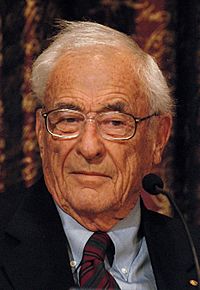Willard Boyle facts for kids
Quick facts for kids
Willard S. Boyle
|
|
|---|---|
 |
|
| Born | August 19, 1924 |
| Died | May 7, 2011 (aged 86) Wallace, Nova Scotia
|
| Citizenship | Canada |
| Alma mater | McGill University Lower Canada College |
| Known for | Charge-coupled device |
| Awards | IEEE Morris N. Liebmann Memorial Award Draper Prize Nobel Prize in Physics (2009) |
| Scientific career | |
| Fields | Applied physics |
| Institutions | Bell Labs |
Willard Sterling Boyle, CC (August 19, 1924– May 7, 2011) was a Canadian physicist and co-inventor of the charge-coupled device. On October 6, 2009, he won the 2009 Nobel Prize in Physics for "the invention of an imaging semiconductor circuit—the CCD sensor".
Life
Born in Amherst, Nova Scotia, he was the son of a medical doctor and moved to Quebec with his father and mother Beatrice when he was three. He was home schooled by his mother until age fourteen, when he attended Montreal's Lower Canada College to complete his secondary education. Boyle attended McGill University, but his education was interrupted in 1943, when he joined the Royal Canadian Navy during World War II. He was loaned to the Britain's Royal Navy, where he was learning how to land Spitfires on aircraft carriers as the war ended. He gained a Bachelor of Science (1947), Master of Science (1948) and PhD (1950) from McGill University.
Career
After receiving his doctorate, Boyle spent one year at Canada's Radiation Laboratory and two years teaching physics at the Royal Military College of Canada. In 1953 Boyle joined Bell Labs a part of Bellcomm, where he invented the first continuously operating ruby laser with Don Nelson in 1962. He also helped invent a semiconductor injection laser. He became director of Space Science and Exploratory Studies at the Bell Labs in 1962. They provided support for the Apollo space program and helped to select Moon landing sites. He returned to Bell Labs in 1964, working on the development of integrated circuits.
In 1969, Boyle and George E. Smith invented the charge-coupled device (CCD). Before CCDs were used in cameras, all cameras used chemicals to capture photographic images. CCDs made electronic photography possible. Boyle and Smith jointly received the Franklin Institute's Stuart Ballantine Medal in 1973, the 1974 IEEE Morris N. Liebmann Memorial Award, the 2006 Charles Stark Draper Prize, and the 2009 Nobel Prize in Physics for inventing the CCD. NASA used the CCD to send clear pictures to Earth back from space. CCD is also used in many digital cameras today. Smith said of their invention: "After making the first couple of imaging devices, we knew for certain that chemistry photography was dead."
Boyle was Executive Director of Research for Bell Labs from 1975 until his retirement in 1979. In retirement, he split his time between Halifax and Wallace, Nova Scotia where he helped launch an art gallery with his wife Betty, a landscape artist. He married Betty in 1947, and has four children, 10 grandchildren and one great-grandchild. He was appointed a Companion of the Order of Canada in 2010. Boyle died in Wallace from kidney disease.
See also
 In Spanish: Willard Boyle para niños
In Spanish: Willard Boyle para niños

